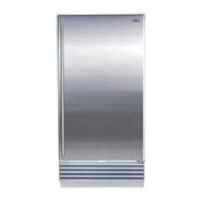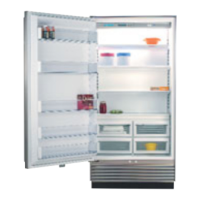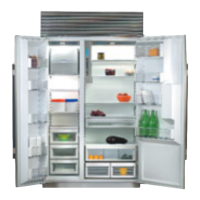KEEPINGFOODAT _T$BEST
FRESHFOOD STORAGE FROZENFOOD STORAGE
Shelflifeoffreshfoodsvariesdependingon
howfreshit iswhenyoubuyit,Tokeepyour
foodfresherlonger,followtherecommended
storagetips.
Vegetables:Washvegetablesincoolwater
anddrain.Storeinairtightcontainersorplastic
wrap.Vegetablesstayfreshlongerinhigh
humiditystorage.
Fruits:Washanddryfreshfruits.Storemore
aromaticfruitsinplasticbags.Mostfruitsstay
freshlongerinlowhumiditystorage.
Prepackaged Meats: Store in original packag-
ing. After opening, rewrap tightly in plastic
wrap or aluminum folk
Fresh Meats, Fish and Poultry: Remove store
wrappings, then rewrap in plastic wrap, foil or
waxed paper and refrigerate immediately.
Eggs: Store eggs unwashed in their carton or
a portable egg tra% Use within 2 weeks.
IVliik, Cream and Cottage Cheese: Keep
carton closed, Store on refrigerator shelf and
use within 5 days.
Cheese: Store in original packaging until ready
to use. After opening, rewrap tightly in plastic
wrap or aluminum folk
Leftovers: Let cool and cover tightly with
plastic wrap or foil. Airtight plastic containers
work well to prevent drying out and odor
transfer.
Freezer Storage: Wrap foods in material
designed for frozen food storage. The wrap
must seal out air and moisture. Do not
refreeze thawed meats.
Ice Cream: The firmness of the ice cream wiii
depend on its cream content, Higher quality
ice creams usually have a higher cream
content, requiring colder freezer temperatures
to maintain their firmness. Soft ice cream is
not always an indication of a temperature
problem.
Make sure your refrigerator and freezer doors
close freely and completel% Overloading will
affect temperatures inside the unit. Do not fill
your freezer with large quantities of unfrozen
foods expecting them to fast freeze. Give the
freezer ample time to circulate cold air around
unfrozen items before adding additional items.
SUGGESTED FOOD STORAblE
The food storage charts on the following pages
give you specific information to help you keep
food safe and keep it at its best quality, The
recommended storage temperatures will help
you determine optimal storage conditions for
your food. As a general rule, food that is
handled properly and kept at temperatures
below 40°F (4°C) will be safe to eat.
Storing food at temperatures below 40°F (4°C)
keeps it out of the Danger Zone. The storage
times for refrigeration will help keep food from
spoiling or becoming dangerous to eat. The
time limits for frozen foods are to maintain
flavor and texture. Food kept frozen longer
than the recommended time will still be safe to
eat, but its quality may diminisL
28

